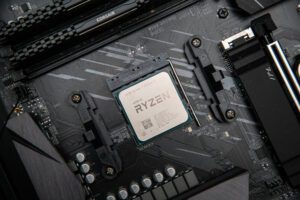To upgrade ram on a laptop, follow these two simple steps: identify the type of ram needed and replace the existing ram module. Upgrading the ram on your laptop can improve its overall performance, especially if you frequently use memory-intensive applications like video editing software or games.
The process of upgrading ram is generally straightforward, but it’s important to ensure you have the correct type of ram for your laptop and that you follow the proper steps for installation. In this article, we’ll provide a step-by-step guide to help you upgrade the ram on your laptop.


Credit: www.engadget.com
Preparations
Upgrading the ram on your laptop can significantly improve its performance and speed, making it a cost-effective way to prolong the life of your device. However, before diving into the process, it’s important to prepare accordingly. In this section, we’ll cover the essential preparations required before upgrading your laptop’s ram.
Checking The Current Ram Installed On Your Laptop
Before proceeding with the upgrade process, it’s essential to check the current ram installed on your laptop and determine its capacity. This will help you understand how much ram you need to add, whether the current ram size is sufficient for your needs, and what type you need to purchase.
To check your laptop’s ram capacity, follow these simple steps:
- Go to your laptop’s start menu and open the ‘system properties’ tab
- Click on ‘advanced system settings’
- Under ‘system properties’, select the ‘hardware’ tab and click ‘device manager’
- Click on ‘memory technology devices’ to see the current ram installed on your laptop
Determining Compatibility Of Ram With Your Laptop’S Motherboard
After determining your laptop’s current ram configuration, it’s essential to ascertain if your laptop’s motherboard is compatible with the new ram you plan to install. Different laptops use different ram configurations, and it’s vital to ensure that your new ram is compatible with your laptop’s motherboard.
To determine compatibility, follow these simple steps:
- Check your laptop’s user manual for ram compatibility information
- Research your laptop’s model and motherboard specifications to determine the compatible ram specifications
- Use online tools to identify the specific ram type compatible with your laptop model
Selecting The Right Ram Size And Speed For Your Laptop
Choosing the right ram size and speed is critical to ensure optimal performance. Consider your laptop’s current ram capacity and the type of tasks you will use it for to determine the appropriate ram size. Additionally, consider the ram speed, as faster ram will improve your laptop’s performance.
Here’s what you need to keep in mind when selecting the right ram for your laptop:
- Determine the maximum size of ram your laptop can support
- Consider your laptop’s memory frequency and choose ram with higher frequency to improve performance
- Choose ram with a size that will meet your needs
Gathering The Necessary Tools For The Upgrade Process
Before starting with the ram upgrade process, make sure you have all the necessary tools at hand. Having the correct tools will ensure that your upgrade process is seamless and successful. Here’s what you’ll need:
- The new ram module
- Screwdriver and screws
- Anti-static wrist strap
- Compressed air
- Soft, clean cloth
Preparing for an upgrade process is as important as executing it. By following these simple steps, you will ensure that your laptop’s ram upgrade process is successful and seamless.
Step-By-Step Guide For Ram Upgrade
Upgrading your laptop’s memory is an excellent way to improve its overall performance. In this blog post, we will take you through 5 simple steps to upgrade your laptop’s ram, from turning off your laptop to powering it back on with the new memory installed.
So let’s get started with our step-by-step guide for ram upgrade.
Step 1: Turn Off And Unplug Your Laptop
The first step in upgrading your laptop’s ram is to turn it off and unplug it. This is an essential step that should not be skipped. If you keep your laptop powered on while upgrading your ram, you risk damaging both the memory and the machine.
Therefore, make sure your laptop is turned off, and all cords are unplugged before you begin to upgrade.
Step 2: Remove The Battery And The Back Cover Of Your Laptop
Now it’s time to remove the laptop’s battery and its back cover. This step varies between laptops, so consult your laptop’s manual for instructions on how to remove the battery and back cover. Be careful when removing the back cover and keep track of the screws.
Place the screws in a safe place to avoid losing them.
Step 3: Locate And Remove The Existing Ram Module(S)
The next step is to locate the laptop’s ram module(s). These are small rectangular chips that are inserted vertically into the motherboard. Before you remove the existing ram module, make sure you have identified it correctly. To remove the ram module, gently push down on the clips on the sides of the module until it pops up out of the slot.
Then, carefully remove it from the slot.
Step 4: Insert The New Ram Module(S) In The Empty Slot(S)
Now it’s time to insert the new ram module(s) into the empty slot(s). Align the notch on the module with the notch on the slot and gently push down on it until you hear a click. The clips on the sides of the slot will snap into place and securely hold the module in place.
Step 5: Reinstall The Back Cover And Battery, And Power On Your Laptop
The final step in upgrading your laptop’s ram is to reattach the back cover and battery. Make sure you replace the screws in the correct order, as specified in the manual. Once you’ve put everything back in place, plug in your laptop, and hit the power button.
If your laptop boots up as it usually does, you have successfully upgraded your ram!
Upgrading your laptop’s ram can improve performance significantly. The process doesn’t have to be daunting or complicated if you follow our step-by-step guide for ram upgrade. By following these five steps, you can upgrade your ram quickly and easily. So go ahead, grab a new memory module, and boost the performance of your laptop now!
Troubleshooting And Common Mistakes
Upgrading your laptop’s ram can be a simple and cost-effective way to boost performance. However, it’s essential to know the common issues that could arise during the upgrade process and how to avoid them. Here are a few tips that will help you troubleshoot and avoid possible pitfalls while upgrading your laptop’s ram.
Possible Errors During The Ram Upgrade Process
Some common errors that you may encounter during the ram upgrade process are:
- Ram not detected: After installing the new ram module, the system fails to detect it.
- Incompatibility with the existing ram: If you mix ram modules with different clock speeds, the system may fail to boot or crash frequently.
- Damaged ram module: If the ram module is damaged, the system may fail to boot or crash frequently.
How To Resolve Common Issues Related To Ram Upgrade
Here are a few tips to help you resolve common issues related to ram upgrade:
- Check the ram compatibility: Before purchasing a new ram module, it’s crucial to ensure that it’s compatible with your laptop. Check your laptop’s user manual or manufacturer’s website for details.
- Check the installation process: Make sure that you follow the manufacturer’s instructions while installing the ram module. Ensure that the module is correctly seated in the slot and tightly secured.
- Run a memory diagnostic tool: To check for any ram-related issues, run a memory diagnostic tool that can help you identify any errors in the ram.
- Reseat the ram: If the system fails to detect the new ram module, try reseating it. Remove the module, clean the contacts, and reinsert it carefully.
- Replace the faulty ram: If the ram module is damaged or incompatible, replacing it with the correct one can help resolve the issue.
Tips To Avoid Damaging Your Laptop During The Upgrade Process
Here are a few tips to help you avoid damaging your laptop during the upgrade process:
- Turn off the laptop and unplug all peripherals before proceeding with the ram upgrade.
- Avoid touching the ram module’s contacts, as it can lead to static discharge and damage the module.
- Handle the ram module carefully, avoiding any drops or hits that could damage the module.
- Store the ram module in an esd bag, and keep it away from moisture and extreme temperatures.
By following these tips, you can avoid common errors and upgrade your laptop’s ram successfully. Remember to have a plan b and prepare yourself for potential mistakes. Good luck with your upgrade!
Frequently Asked Questions On How To Upgrade Ram On Laptop
How Can I Tell If My Laptop Needs More Ram?
There are a few signs that your laptop needs more ram including slow performance, freezing, and frequent crashes.
Can I Upgrade My Laptop’S Ram Myself?
If you have the right tools and some basic technical knowledge, you can upgrade your laptop’s ram yourself.
What Should I Consider When Upgrading My Laptop’S Ram?
When upgrading your laptop’s ram, you should consider compatibility, the maximum capacity of your laptop, and the type of ram needed.
Conclusion
By upgrading the ram on your laptop, you can drastically improve its performance and increase its lifespan. While the process may seem daunting at first, it is actually quite simple if you follow these steps. Firstly, ensure you have the right ram for your laptop and disconnect all power sources before beginning.
Next, locate and remove the existing ram and carefully insert the new ram into the slot. Finally, secure the ram in place and reconnect all power sources. With a little bit of patience and attention to detail, you can upgrade your laptop’s ram and enjoy a faster and smoother computing experience.
Don’t let your laptop’s slow performance hold you back any longer – follow these steps and enjoy the benefits of increased ram.



